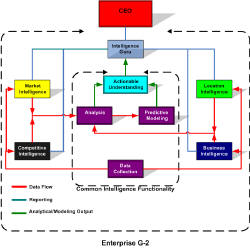What seems to be of less interest is what the top people are actually doing. This is where the buck stops and that top person should know what’s going on. Unfortunately, this is not always the case. The complexities of modern business, combined with the geographically dispersed nature and speed of business today, make it difficult for even the most astute to understand the entirety of the enterprise and the world within which it operates. Also, there is the competence factor, what I like to call "Reid’s Law of Organization," which states, "The higher the person is in the organization, the less he is missed when on vacation."
The world of Location Intelligence has built numerous structures which can provide knowledge and understanding (applied demographics, market maps, lifestyle segmentation, etc.) and even actionable insights. Other comparative structures have been built within the disciplines of Business Intelligence, Competitive Intelligence and even Market Intelligence. It is logical that there is a natural affinity and common purpose among these four disciplines.
In the 21st century, because of the need to know, businesses may need to initiate a department that contains all the four functions of LI, BI, CI and MI and is headed by a guru inside the enterprise who can provide the top spot with the insight and understanding necessary to guide the enterprise in this century.
 |
This department could generate a multi-faceted view of what you are doing now and what they (your competitors) are doing or going to do, and could develop effective counter-strategies. This group might even model the possible outcomes of actions taken.
It seems obvious that a business needs this function and that without it, the business is probably extremely vulnerable on a number of levels. True, this need was loosely addressed by what used to be "the strategic planning department," but they never had the advantage of the Web, or the technologies and techniques available today, or the four disciplines (LI, BI, CI and MI). Speaking of antiques, remember that strategic planning came up with the old five-year plans? Who does that today?
There is intelligence available to the enterprise. But the source is most likely to be various newsletters, industry publications and outside contacts that are probably in middle management or in sales, rather than in the top spot. These sources may also be a little too general to create anything actionable when viewed from the top of the organization.
But if we add something, shouldn’t we take something away?
To make the flow of information faster and more efficient, some companies have moved to a core competency mode, shedding parts that were generic and could be outsourced. In so doing, they have inherently reduced the lines of communication, because there is less organization left with which to communicate. Knowledge doesn’t have to travel as far. Many companies have gone virtual, adding and subtracting contractors as the need arises, focusing on their key skill sets. Even General Motors has outsourced IT to unload $15B outside the company.
If GM thinks that IT can be outsourced and IT has traditionally reported to finance, can finance be outsourced as well? Perhaps to a big bank that is holding the paper anyway? Maybe next is HR, and then production. After all, don’t Intel, Nike and others outsource production? Wal-Mart certainly does.
With finance and IT and operations/manufacturing gone, what remains in the new organization could be:
- New product development
- Marketing/sales
- The Intelligence department
- Some administration to run the flexible contractors
- The CEO
 |
Sure, this won’t work in every enterprise, but it is interesting to think about how much faster things could go with better insight and focus. Consider the effects of an increase in knowledge and understanding at the highest possible level. Actions could be augmented or tempered by an understanding of the potential effects of those actions.
The traditional pyramid of data moving up to knowledge, to understanding and occasionally to wisdom, shows the flow of data as processed raw material. When we move data to knowledge and understanding we have the basis for enterprise intelligence. But it must be multifaceted and include those disciplines (LI, BI, CI and MI) which can provide as complete a picture as possible of enterprise environment.
 |
It’s "so 20th century" to still be banking on experience or gut feel. You have to ask yourself the question, how astute is your enterprise’s intelligence? If it isn’t too astute, it may be time to think about having a new C-level role and a new department to correct that problem, and get you into the 21st century.